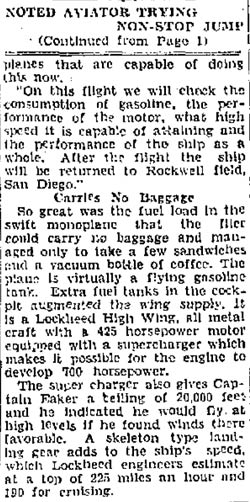|
Ira Clarence Eaker was born at Field Creek, Llano, Texas,
13 April 1896 and died at Andrews Air Force Base, Camp Springs,
Prince Georges, Maryland, 6 August 1987. He was, among military
flyers, one of the most frequent visitors, having landed at
the Davis-Monthan Airfield 16 times between 1925 and 1931.
He flew military aircraft, many times carrying VIPs as
passengers.
Below, a crisp, spring day image of Eaker taken on Monday, April 7, 1931. This image is from Tim Kalina, who has shared many of his images with dmairfield.org. Thanks to him for his photographs.
Ira C. Eaker, April 7, 1931, Burbank, CA
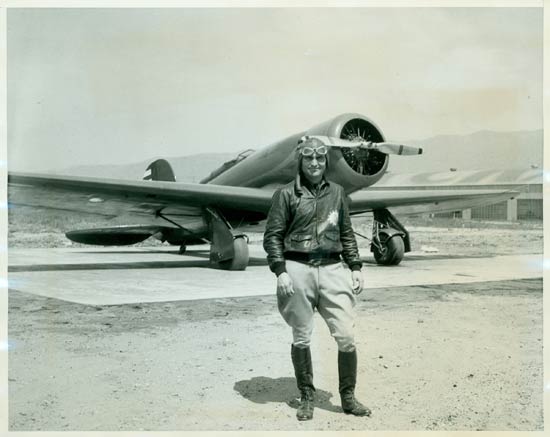 |
Mr. Kalina says this image is, "...an original newsphoto of Ira Eaker and the prototype Lockheed Altair NR119W (originally a Sirius c/n153) which he used on a cross-country record attempt. This photo was taken at the old Lockheed plant in Burbank and, most likely, the plane is brand new. The USAAC later purchased the plane becoming their Y1C-25.
"This plane differs from the Y1C-23 which Eaker landed at D-M [registered as NR8494, q.v.] in that the Y1C-23 had a metal fuselage. The all-wood Y1C-25 was slightly faster than the Y1C-23, probably due to it’s lighter weight....This was the very first Altair and was the only Altair/Orion to have the square-cut landing gear (note the front edge of the main gear covers). Note too the mud guards on the wheels which were fitted to a few of the low-wing retract gear Lockheeds. These must have been a problem (clogging with mud/dirt?) as nearly all fitted were later removed. Note the Bolling Field logo on Eaker’s flight jacket."
Note, too, the well-conditioned A-1 jacket, and the trousers and boots similar to those here. Below, the inscription on the back of the photograph above.
Photograph Inscription, April 7, 1931
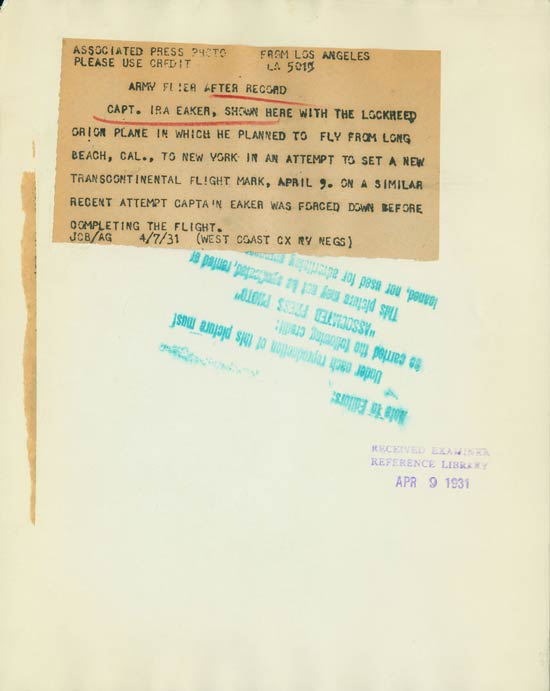 |
Google has many hits on "Ira Eaker", providing
additional biographical information and images. The following is taken from this downloadable (PDF) book (see reference linked at left for a jaunty image of
Eaker).
"Ira Clarence Eaker (1896- 1987) was commissioned a
second lieutenant of infantry in 1917. Within six months he
decided he wanted to fly. Lieutenant Eaker received his pilot's
wings in 1918.
"During the interwar years, Captain Eaker helped defend Brig
Gen William 'Billy' Mitchell in his court martial
for insubordination in 1925; piloted one of the planes on
the 22,065-mile Pan American goodwill trip of 1926-27; flew
with others, such as Majors Henry
H. "Hap" Arnold and Carl
A. "Tooey"
Spaatz, in 1929 on the trimotored Fokker [28-120] that set an in-flight
refueling endurance record of 150 hours (11,000 miles and
43 aerial re-fueling, all over Los Angeles); and flew the
first transcontinental instrument flight in 1936.
"His flying included somewhat more routine work: commanding
two pursuit squadrons, commanding the Western Zone routes
when the Air Corps carried the airmail in 1934, and participating
in the Pacific naval maneuvers in 1935.
"During the interwar years, Eaker also furthered his education.
He studied at the University of the Philippines (1920-21),
Columbia Law School (1922-23), and the University of Southern
California (1932-33). He took a degree in journalism from
the last.
"In 1935-37, Major Eaker attended the Air Corps Tactical School
at Maxwell Field and the Army Command and General Staff School
at Fort Leavenworth, Kansas. While together at school, Eaker
and Hap Arnold wrote This Flying Game (1936), the first of
three books they would write together. Winged Warfare, which
stressed the need for a separate air force, followed in 1941;
Army Flyer, which explained the duties and rewards of being
a pilot, was published in 1942.
"Rapid wartime promotions followed: colonel in December 1941,
brigadier general in February 1942, major general in September
1942, and lieutenant general in September 1943. His fourth
star did not come until 1985, almost 38 years after he retired.
These promotions, and Ira Eaker's place in history, rest on
his two World War II combat commands.
"From 1942 until the end of 1943, he commanded US bombing
efforts from Great Britain. An advocate of high-altitude daylight
precision bombing as taught at the Air Corps Tactical School,
Eaker insisted that the B-17 Flying Fortresses fly combat
missions over Europe as they had been trained to do. In August
1942 Eaker himself flew one of the aircraft in the first American
bombing raid over Nazi-occupied France. Subsequently he flew
bombing raids over Germany. The absence of adequate fighter
escorts resulted in crippling bomber losses, especially in
the large raids against Schweinfurt and Regensburg. Eaker,
as commander of the Eighth Air Force, bore much of the blame.
"From 1944 to April 1945, he commanded the Allied Air Forces
in the Mediterranean theater. Flying first from North Africa
and then from Italy, his air assets were involved in many
missions. They helped keep the sea lanes open, air dropped
supplies to anti-Nazi partisans in the Balkans, bombed southern
Germany and the Romanian oil field at Ploesti, and provided
air support for landings in southern Italy and southern France.
In August 1944 he personally flew a fighter supporting the
invasion in southern France.
"After assignments as deputy commander of the Army Air Forces
and chief of the Air Staff, Lieutenant General Eaker retired
in 1947. He continued to write about defense posture. For
18 years he wrote a syndicated column for more than 180 newspapers.
An exhibit in Air University's [Maxwell AFB, Montgomery, AL]
Ira C. Eaker College for Professional Development on Chennault
Circle houses Eaker memorabilia."
---o0o---
Mentioned above as the, "... 22,065-mile Pan American goodwill trip of 1926-27," Eaker's participation in that trip was as pilot of the Loening Amphibian named the "San Francisco." He was in good company, with Register pilots Whitehead, McDaniel, Thompson and Weddington accompanying him.
The "New York" -Major Herbert A. Dargue, pilot and commander of the flight; First Lieutenant Ennis Whitehead, copilot.
The "San Antonio" -Captain A.B. McDaniel, pilot; First Lieutenant Charles McK. Robinson, copilot.
The "San Francisco" -Captain Ira C. Eaker, pilot; First Lieutenant Muir S. Fairchild, copilot.
The "Detroit" -Captain C.F. Woolsey, pilot; First Lieutenant John W. Benton, copilot.
The "St. Louis" -First Lieutenant Bernard S. Thompson, pilot; First Lieutenant L. D. Weddington, copilot.
Below, a photograph of the "San Francisco" courtesy of a site visitor from New Mexico.
The Loening "San Francisco," Ca 1927, Location Unknown (Source: New Mexico)
 |
The pilot standing at far left has a resemblance to Eaker.
---o0o---
Below, from Eaker's NASM biographical file (cited, left sidebar), is this kind letter written by Dwight Eisenhower to Eaker upon the occasion of his retirement.
Letter, Eisehower to Eaker, June 13, 1947
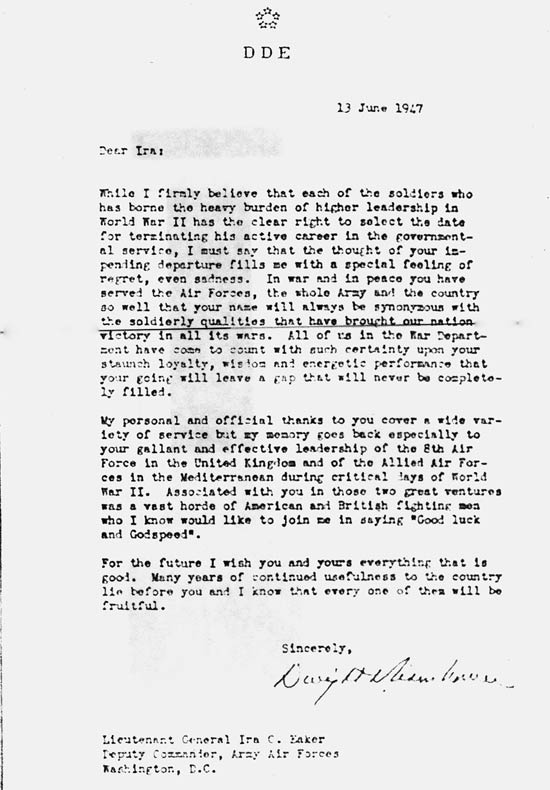 |
---o0o---
On December 8, 2008 I added the following. During March 1931 (about a month before the image at the top of this page was taken), Eaker made a cross-continent speed record attempt in a modified Lockheed Vega assigned the military type Y1C-17 with registration number 31-408. Mike Gerow provides very clear images taken by his father at Long Beach, CA during preparations for one of the attempts. See this article from the Syracuse, NY Herald of March 10, 1931 for a description of the intentions of Eaker for a planned cross-country flight with the airplane pictured. Details are provided by Mike below.
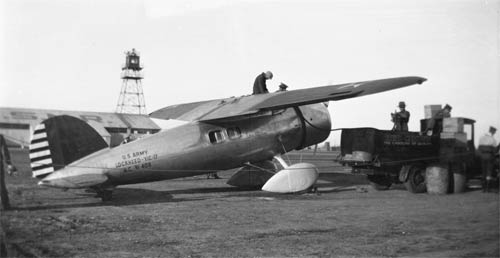
The Army’s fastest plane during its brief existence, Y1C-17 is shown gassing up at Long Beach Airport shortly after its 2:00PM arrival from Rockwell Field, San Diego, where its brief flight test regimen was conducted. Y1C-17 was a specially modified Lockheed Vega ostensibly built to capture Capt. Frank Hawk’s existing cross-country speed record, a claim promoted by the press but consistently denied by Y1C-17’s pilot, Capt. Ira C. Eaker of later WWII fame. Some 12 hours after this picture was taken, the heavily laden aircraft—loaded with 486 gallons of fuel—experienced two aborted take-offs, both times veering dangerously close to the line of civilian hangars. On its third try, the craft finally became airborne at 2:13 AM on March 10, 1931. On the bumper of a tail wind, Y1C-17 averaged almost 236 mph but crashed later that morning in eastern KY due to fuel line problems. Curiously, U.S.N.R. on the adjacent building reveals this scene to be the Naval Reserve Aviation Base, not the U.S. Army facility about 3/4 mile off the nose of the ship on the far eastern end of the field.
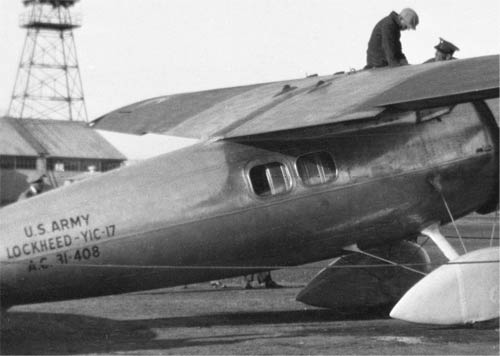
Detail of previous picture showing special long-range gas tanks visible though windows of passenger compartment. Y1C-17 was completely destroyed with only 33 hours on its airframe. R.T. Gerow Collection
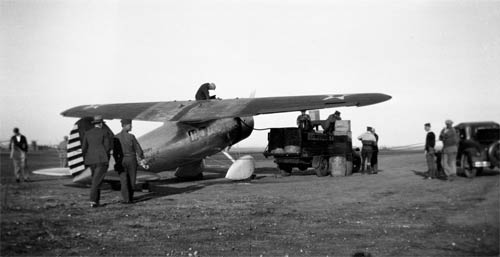
Y1C-17’s natural metal finish was complemented by yellow flight surfaces, red and white rudder stripes and white wheel pants. These photos were snapped by Continental Air Map mechanic and photographer, Russ Gerow, on the afternoon of March 9, 1931. R.T. Gerow Collection
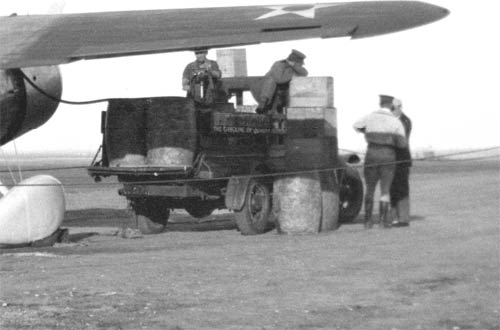
Detail of above photo. Capt. Eaker, back to camera, in discussion, with Army ground crewman in bed of truck listening in. Note man at left operating a bicycle-action fuel pumper. Sign on side of truck reads “Red Crown the Gasoline of Quality. Small crates behind fuel pumper read “Stanavo,” the commercial aviation-grade gasoline and lubrication line introduced by Standard Oil of California (Socal) in 1929. In 1984 Socal became Chevron, since merged into ChevronTexaco. Russ Gerow photo, R.T. Gerow Collection.
|
Further, Mike provides the following news clip reportage related to Eaker's attempted flight with the Lockheed. Below from the Abilene, TX Daily Reporter of March 10, 1931.
Below, from the Billings, MT Gazette of March 11, 1931 we find that he didn't complete the flight.
---o0o---
These weren't the only long-distance, cross-country flights Eaker attempted. The Fresno Bee of August 29, 1929 (link, left sidebar) headlines a U.S. mail flight ("Shuttle Forced Down By Falling Can In Refueling"), with air-to-air refueling, attempted with Register pilot Lt. Bernard S. Thompson as his co-pilot.
---o0o---
Further information available at National Air & Space
Museum as follows:
EAKER, Ira Clarence Papers
(1903-1982)
.75 cu ft, 41 reels negative microfilm
Call No. 168.7126, 23175-23216
IRIS No. 1032944-1032963, 1036997, 0891450-0892758
(1896-1987). General. USAAF, 1920-1947.
Born 13 April 1896, Field Creek, TX. BS, Southeastern Normal
College, 1917; BA, U of Southern California, 1933. Air Corps
Tactical School, 1936; Command and General Staff School, 1937.
Commissioned Second Lieutenant, Infantry Reserve, August 1917
and served to grade of First Lieutenant, 1917-1920; advanced
to Captain, Air Service, July 1920. Career assignments include:
various duties as company and field grade officer, 1920-1941;
including pilot in the Pan American Flight (1926-1927), and
pilot of the aircraft, "Question Mark," on its refueling
endurance flight (1929); concurrently Commanding General,
VIII Bomber Command and HQ Detachment, Eighth Air Force, 1942;
concurrently Commanding General, Eighth Air Force and USAAF
in the United Kingdom, 1942-1944; Commander-in-Chief, Mediterranean
Allied Air Forces, 1944-1945; Deputy Commanding General and
Chief of Air Staff, HQ USAAF, 1945-1947. Retired as Lieutenant
General, August 1947; promoted to General by direction of
the President, 4 April 1985. Vice President, Hughes Tool Company,
1947-1957; Executive, Douglas Aircraft Company, 1957-1961;
Consultant, Hughes Aircraft Company, 1967; Syndicated Columnist,
Copley News Service, 1964-1974, and Los Angeles Times Syndicate,
1974-1982; Founding President, United States Strategic Institute,
1973; Vice President, United States Strategic Institute, 1973.
Died 6 August 1987, Malcolm Grow Air Force Medical Center,
MD. Honors include the Wright Trophy and the Congressional
Gold Medal (1979). Co-author with General Henry H. Arnold
of This Flying Game (1936, revisions in 1938, 1943), Winged
Warfare (1941), and Army Flyer (1942). Personal and official
papers relating to Eaker’s military service and post-retirement
occupations. Includes personal (1950-1982) and official (1962-1972)
correspondence. Also includes speeches and briefings (1966-1980)
as well as a comprehensive collection of news release drafts
on national security and related issues written by Eaker (1926-1980).
Also includes a transcript of an interview with General James
H. Doolittle on the ethical issues of bombing during World
War II (1979). Contains brochures and other mementos of conferences,
meetings, and trips (1966-1975), and copies of selected magazines
(1970-1981). Also includes a copy of the Handbook of Radio
Range Data (1935). Also contains numerous photographs (1903-1976)
including those taken during World War II, during the Pan
American Flight (1926-1927), of the Lockheed XP-80A (1948),
and of the Besler Engine Mounting System (1932). Most of the
materials are available on microfilm only. Originals located
at the Library of Congress. Access to some materials restricted
by security classifications and USAF administrative markings.
Related materials located elsewhere in the Document Collection,
Air Force Historical Research Agency, include transcripts
and/or tapes of oral history interviews and comments by Eaker
(1962, 1964, 1966, 1970, 1973). Also includes diaries, speeches,
lectures, and addresses 91945-1965); press conferences and
interviews (1943-1944); reports (1942-1943), and other miscellaneous
files by or about Eaker. Related materials located elsewhere
in the Air University Library (AUL) include article by and
about Eaker (see AUL Index to Military Periodicals, 1957-1987)
as well as copies his three books. Related materials referenced
elsewhere include Eaker’s papers located at the Library
of Congress, Manuscript Division and at the US Army Military
History Institute (National Union Catalog Manuscript Collections,
MS 66-1402, MS 79-1427).
---o0o---
UPLOADED: 12/23/05 REVISED: 07/26/07, 11/04/07, 04/14/08, 07/11/08, 12/08/08, 12/15/08, 02/03/09, 01/07/12, 03/28/13
|












